
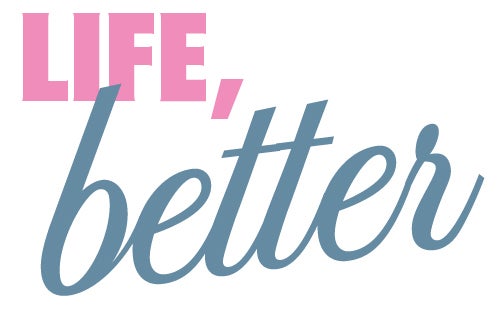
By Ellen Liberman with Todd McLeish and Pippa Jack
We’ve gathered tips, factoids and expert advice from every corner of URI, for you to use in your everyday (and not so everyday) life. Read on to find out how to raise chickens, stay safe online, get your whites whiter, have better arguments with your spouse, and—just in case—what to do if you find yourself in prison.


It’s a weeknight, the kids are hungry, work ran late and the fridge is empty. The only question: What size pizza are you ordering?
James Baglama, chair of URI’s Mathematics Department, can help. His local is Kingston Pizza, where a small 10-inch pie with one topping rings in at roughly $7, while the Big City 18-incher costs $16.
“It seems two 10-inch pizzas, with a total cost of $14, is giving you more pizza for less money than the 18-inch pizza,” Baglama observes. “But is it?”
Assuming uniform thickness and setting aside the thorny issue of topping choice, Baglama walks us through the math. “The formula for the surface area is (π/4) x D2, where D represents the diameter,” he says. “A 10-inch pizza has a surface area of (π/4) x 102—about 79 square inches. An 18-inch pizza has a surface area of (π/4) x 182—about 254 square inches. So, two 10-inch pizzas (79 +79) give you about 158 square inches of pizza, while the 18-inch pizza gives you 254 square inches.”
Follow that? Here’s the take-away: There is more surface area in one 18-inch pizza than in three 10-inch pizzas. So go ahead: order the large!

You’ve heard it before, but Sue K. Adams, associate professor of human development and family studies, wants to make sure you hear it again: Phones are bad for your sleep.
“According to the Pew Research Center, 95 percent of Americans own cellular phones, 77 percent of them smart phones,” Adams says. “But phones aren’t so smart when it’s time for bed. My research has found that college students sleep only about six hours per night, when they need nine. One of the most commonly cited reasons is FoMO (Fear of Missing Out). A smart phone is like a FoMO generator, disrupting the journey to dreamland with alerts and lost hours checking emails or perusing social.
“Other research has shown physiological reasons smart phones impair sleep: their blue light tricks your brain into thinking it is daytime and suppresses melatonin production; and even with a blue-light filter, phones are an active form of technology, versus watching television, which is passive.
“So shut off email and social media alerts and place the cell phone out of reach—and not at your bedside. Apps such as Offtime, Moment and Flipd can help break the habit.”
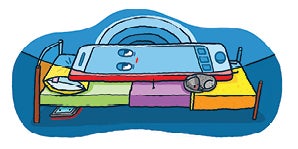

It’s a loud world. And by age 65, nearly half of the population will pay for it with some degree of hearing loss. Unlike a Saturday Night Live “News For the Hard of Hearing” skit, hearing loss isn’t amusing. It can be frustrating for the speaker and isolating and embarrassing for the listener.
“Some withdraw, some feel hostile, and some people experience a grieving process. It’s a change you did not initiate and that’s tough,” says Bethany Milner, M.S. ’94, a lecturer in URI’s Department of Communicative Disorders.
Conversation can become a puzzle to solve. “People describe it being like Swiss cheese—there are holes,” says Milner. “So people with hearing loss are always looking for supplemental information. We have a term for it: bluffing. A nod and a smile, for instance, might be the path of least resistance—but that strategy isn’t good for either conversational partner. It’s not getting the job done.”
Here’s how the fully functional speaker can help:
1. Speak face-to-face: All of us speech-read—scan the speaker’s facial expressions, gestures and body language for more information about the words being spoken. Give the listener that boost of visual data. Optimum conversational distance: 6 feet.
2. Eliminate background noise: CNN, the swirl of party chatter, the clink and rattle of cutlery and glasses—these things are the enemy. Turn off TV and radio, and choose the restaurant table in a corner with good lighting.
3. No shouting: Don’t amp up the volume too high or slow your words to a crawl—you risk causing insult, and even discomfort if your listener has a hearing aid. Speak slightly slower and slightly louder, allowing the conversation to flow in a natural way.
4. Vary your vocab: If the listener doesn’t catch something after two tries, repeat it using different words. Sometimes it’s the combination of particular sounds with the pitch and intonation of your voice that creates the “holes.”
5. Keep your sense of humor: People often mistake hearing loss for indifference, or assume the person they’re addressing is ignoring them. These communication snafus—and their attendant hurt feelings—are more common than people realize. A reframe may be in order: “They just didn’t hear you,” Milner says. “It’s worth thinking about.”

 Writing effectively depends more on good routines than talent or inspiration. Whether you need to write a brief email or a long document, give yourself time to generate the main ideas and express them cogently.
Writing effectively depends more on good routines than talent or inspiration. Whether you need to write a brief email or a long document, give yourself time to generate the main ideas and express them cogently.
Baby steps. Make a list of questions, jot down a few lines, create the document and name it.
Just start. Get some words down, without worrying how they sound. Don’t labor over the opening lines—start anywhere, and come back to the intro when you’re ready.
Readers first. Once you have a draft, re-read with your audience in mind. Where do you need more explanation, or say too much? What is the best order? If it’s high stakes, ask colleagues to tell you what’s working and what needs attention.
Edit, then edit again. Devote some time to focus on sentences, getting rid of unnecessary words, checking word choices, adding transitions. Correct spelling errors and other typos.
Step away. Returning to the work after a break helps you see it fresh. Whether your break is 10 minutes or 24 hours, leave yourself a note about where to start again.
Print. If you compose on screen, try printing a copy to see it from a different perspective. If that’s not possible, change the font size or color to trick your brain into seeing it afresh.
By Nedra Reynolds, professor of writing and rhetoric in URI’s Harrrington School of Communication and Media

 You’ve made the decision: Your household is going sustainable, and it starts with home-grown eggs. Heidi Wright ’90, URI Cooperative Extension’s 4-H program coordinator, says don’t count your chickens before you’ve done your six-step homework:
You’ve made the decision: Your household is going sustainable, and it starts with home-grown eggs. Heidi Wright ’90, URI Cooperative Extension’s 4-H program coordinator, says don’t count your chickens before you’ve done your six-step homework:
1. Zoning Laws: “You don’t want to invest in these chickens and find out you have to rehome them,” Wright says. “It can be tricky, because a lot of cities and towns flip-flop on backyard chickens.”
2. Hen House: Chickens are considered delightful dining by more than humans, so the coop should be sturdy and the chicken run well fenced. Extend the run fence a foot below ground, to discourage digging predators such as foxes, and at least three feet above ground, to discourage climbing predators such as raccoons. You’ll also need a roof to keep wild birds from transmitting disease. Each chicken needs 2.5 to 3 square feet of coop space, and 6 to 8 square feet of run.
3. How Funky is Your Chicken?: Domesticated for thousands of years, chickens come in hundreds of breeds. If you’re all about egg production, try a Red or Black Sexlinks hybrid. Fancy something fancy? The Polish Crested or the Barred Rock are pretty enough for a Martha Stewart Living spread. The cutest little chickens are bantams, while Jersey Giants or Buff Orpingtons are “big, snuggly chickens,” Wright says.
4. No Foul Fowl: Wright advises buying your chickens from a National Poultry Improvement Plan hatchery. Started in the 1930s to combat the spread of salmonella in chicken flocks, NPIP facilities test for a variety of avian diseases. Your local vet, extension office or poultry club can help with advice and resources too.
5. The End of Eggs: Chickens start laying eggs at about 20 weeks and continue producing for up to two years. After that, your chickens will lay inconsistently—but might live another six or seven years. You can send them off to a livestock auction or slaughtering facility, but Wright recommends you sit back and enjoy. “They are like pets, very sociable,” she says. “Sometimes after a stressful day, I put my feet up and watch them do their chicken-y things—pecking, putting an eye to the sky. I had one who was a real gossip. If she heard us talking, she’d run over to see.”
6. Caution: Chickens are addicting, Wright warns, and can lead the unwary deeper into animal husbandry. She’s seen it happen to many a 4-H family that never even owned a dog: “Chickens are gateway livestock.”

 Maybe the waitress is a bit taken aback when he hands her the Tupperware container he brought for his restaurant leftovers, but Rainer Lohmann doesn’t care.
Maybe the waitress is a bit taken aback when he hands her the Tupperware container he brought for his restaurant leftovers, but Rainer Lohmann doesn’t care.
Lohmann, an associate professor of oceanography and director of the Lohmann Lab at URI’s Graduate School of Oceanography, studies persistent organic pollutants in the world’s oceans, lakes, and atmosphere. But he is just as vigilant against inorganic pollutants. Each year, 300 million tons of plastics are produced worldwide—half for single use—and more than 8 million tons are dumped in the ocean. There is no good solution for plastic waste, so Lohmann just says no to disposable plastic every time he can. You can, too.
1. Carry your own bags for all purchases.
2. If you bring your lunch to work, keep metal utensils on hand.
3. Bring your food in a glass container; an old jar works well.
4. Get your take-out coffee in your own travel mug.
5. Never dine out without Tupperware. “The waitress may say ‘Oh, you brought your own, how good,’” Lohmann says. “It’s a little strange, but people know you are doing the right thing.”

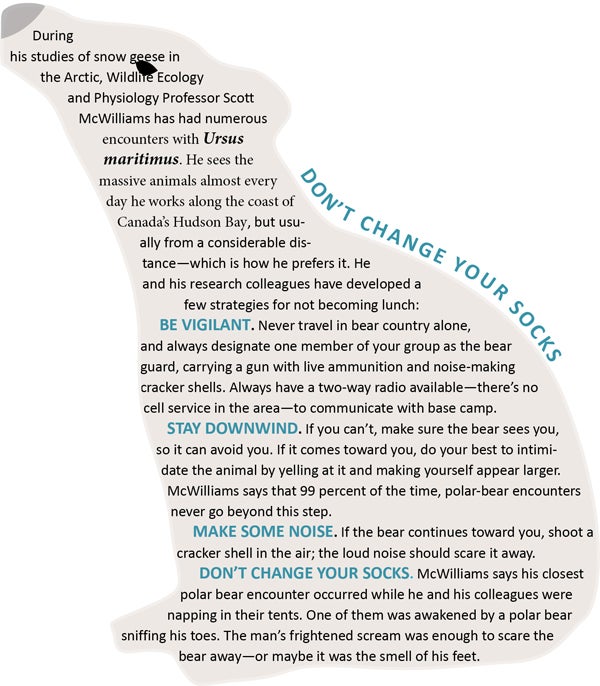

Smart phones and social media platforms are ideal for sharing information, as long as the communication is direct—and brief. That’s because the average attention span of a human being is…oh, wait a minute, my boyfriend is texting me.
Scientists say technology has rewired our brains and our ability to stay on task. A recent survey of media consumption by Microsoft concluded: “The average attention span has fallen to eight seconds, down from 12 in the year 2000. We now have a shorter attention span than goldfish.” (The attention span of goldfish is believed to be nine seconds).
So, keep it snappy when you’re socializing digitally. And remember: technology has made life easier, but could also have strange effects on human behavior. I’d Google them, but it might take longer than eight seconds.
By Jane Fusco ’76, marketing manager at URI’s Alan Shawn Feinstein College of Education and Professional Studies

 Most wines are 98 percent water and ethanol, says Biotechnology Professor Edward Bozzi ’68 of URI’s Alan Shawn Feinstein College of Education and Professional Studies, so it’s the other 2 percent that distinguishes one wine from another—and a great wine from an average one.
Most wines are 98 percent water and ethanol, says Biotechnology Professor Edward Bozzi ’68 of URI’s Alan Shawn Feinstein College of Education and Professional Studies, so it’s the other 2 percent that distinguishes one wine from another—and a great wine from an average one.
So what’s in that 2 percent?
Half is glycerol, says Bozzi; it changes wine’s viscosity. When you see “legs” or “tears” on your glass after swirling the wine, it’s thanks to glycerol, and there’s a name for it: the Marangoni effect.
Wine is somewhat acidic, so there’s tartaric acid in the mix, at around 0.5 percent. Then there are carbohydrates; sweeter wines contain more fructose and glucose than the dry ones, but we’re still talking around half a percent.
Finally, at just 0.1 percent, it’s the phenolics that make wine special. Flavonoids and anthocyanins, in varying proportions, give wines distinctive colors and tastes. Phenolic tannins give you a feeling of dryness.
“Now that you know a little more about wine’s chemistry,” says Bozzi, “perhaps your next glass will taste even better.”

The U.S. incarcerates more people per capita than any other nation. In 2016, some 2.3 million adult and juvenile Americans were imprisoned in a jail, a prison or a federal detention center. Safely surviving life in a correctional facility requires a series of adjustments in thinking and behavior—you’re in a confined space now, and surrounded by predators. Leo Carroll, a professor of sociology and former correctional officer who teaches policing, punishment and corrections, and criminal justice policy, offers this survival guide.
Get a lawyer. If you’re in jail awaiting trial, don’t talk to the police—at all. Police are legally allowed to lie to suspects during interrogations, and have many methods of soliciting damaging statements. “In some cases people have been sent to prison for very long sentences when later evidence—such as DNA—has shown them to be innocent,” Carroll says.
Put on your prison mask. Don’t show fear, and don’t confide anything personal. “There are people looking to exploit others,” Carroll says. “If someone wants to be your friend, that’s a danger sign that they are more likely to be a predator.”
Keep your distance from the COs. Your stock in the prison population will plummet if you appear to be friendly with the guards. Comply with what they tell you, but don’t be eager to do it. Carroll recalls one inmate who stood for the daily count, but with his back to the cell door—or wore his prison uniform with some small alteration. “It’s a little thing—you don’t control all of me,” Carroll says. “That’s a message to the correctional officers and a message to other inmates.”
Make yourself useful. Find a niche that takes advantage of your education and skills and makes them available to other inmates. Many of your peers can’t read or write. Write letters for them or get a job as a clerk in the law library. This can keep you busy—and safe.
Don’t join a gang if you can help it. This isn’t a problem in some prison systems. But in others, guards only control the perimeter and the use of force, and gangs run everything else. If the gang tells you to do something, you will have to do it, or it will be done to you.
Avoid conspicuous consumption. People can put money into a prison store account that will allow you to buy yourself some goodies. Carroll advises: “Don’t do it to excess. You can get ripped off. Or, you can find yourself having to pay tribute to someone.”

The way a couple fights is one of the most accurate indicators of relationship satisfaction. Jerome Adams, professor of marriage and family therapy, says there are tools for keeping your inevitable disagreements as relationship-friendly as possible.
Pick the right time and place Resist the temptation to hash things out at vulnerable moments. It’s much more effective to say, “I want to work this out, but I’m not at my best right now. Let’s discuss it another time.” You can also call a “time-out” or change the subject when you feel things are getting out of hand, resolving to finish the discussion when each party has cooled off. The partner who calls time-out resumes the conversation at a later date.
Stay on topic If you’re fighting about the fact that he left you stranded at his sister’s wedding, then stick to that grievance. This is not a good time to throw in that she never puts her dirty clothes in the laundry hamper. Bringing up past hurts and complaints will put your partner on the defensive.
Pick your battles Sometimes you just have to accept that your partner will always be 15 minutes late and will never learn to see the black stuff that grows between the bathroom tiles. If you’re always picking a fight about little things, it will be hard to get him or her to listen to the big stuff. Researchers estimate that only 31 percent of couples’ major areas of continuing disagreement were about resolvable issues. So 69 percent of the time, they were about perpetual problems. Unsuccessful couples stockpile grievances, while successful couples know what to let go—and how to accept their partner with humor, affection, and even amusement.


Most of us will invest a great deal of time researching our doctors, but very little on our pharmacist—a convenient location usually trumps other considerations. Yet your pharmacist is the drug expert for every member of your family—particularly important when someone is taking multiple medications, possibly prescribed by different doctors. It’s the pharmacist who evaluates the regimen for potential drug interactions and side effects, as well as giving recommendations and counseling on over-the-counter medication and vaccines.
So how do you pick the right one? Introduce yourself, either in person or over the phone. Ask questions and determine if the pharmacist: provided accurate, clear information; gave you undivided attention; offered to research your questions further if necessary. If the pharmacy was too busy to give you one-on-one time, or you’re otherwise unsatisfied, you have the choice to fill your prescriptions at another pharmacy. A pharmacist is not just a pill dispenser, but an integral part of your health-care team.
By Ginger Lemay, Pharm.D. ’00, clinical associate professor at URI’s College of Pharmacy

What to do if you’re stopped by the police
No one grabs the car keys anticipating an encounter with the law. But if you see flashing blue lights in your rearview mirror, don’t panic. You may drive away with a ticket, says URI Director of Public Safety Stephen Baker, but at least you’ll drive away.
• Pull over in a safe spot, as far from the side of the road as possible. If there is a parking lot nearby, go there. If it’s at night, try to choose a well-lit spot, and turn on your interior lights so the officer can see inside your vehicle.
• The officer could approach from either side of your vehicle—roll both windows down.
• Keep your hands visible and on the steering wheel.
Remain still unless the officer asks you to get something.
• If you have to retrieve your license and registration, tell the officer where you are moving to comply with the request: “I’m going into my glove box to get my registration.”
• If you have passengers, ask them to be quiet and to leave the exchange with the officer to you.
• If you really have no idea why you’re being stopped, you can ask the officer, but don’t demand answers. Most will tell you, but they may have reasons not to—such as when police are on the lookout for a vehicle similar to yours that is associated with criminal activity.
• In most states, it’s legal to tape the encounter, even though the officer might not like it. If you want to do that, don’t put the cell phone in the officer’s face. Set it down to record—you shouldn’t have anything in your hand.
• You can ask for the officer’s name and badge number, but don’t argue at the scene. Once the ticket is written, it won’t be retracted. If you feel you weren’t committing an infraction, you’ll get a chance to argue your case in court. “Escalating the situation never helps,” Baker says. “You don’t want to raise suspicion. Most traffic stops are for minor violations like speeding, so don’t turn a minor thing into a major confrontation.”
• If you have a complaint with the way you were treated, deal directly with the officer’s superior after the encounter. “You can ask to see the officer’s supervisor at the scene, but that might not be the best course of action,” Baker says. “Calling the police station after leaving the stop and making an appointment to speak with the officer’s supervisor ensures that things de-escalate sooner rather than later. You can give your account, and the supervisor will read the officer’s report and get back to you with potential resolutions.”
“You want to end the encounter as soon as possible, and end it without any aggressiveness,” he says. “Everybody goes home safe. That’s the main thing.”

 There are at least 176 different species of mosquitos in the U.S., and at dusk in the warmer months, it may feel like all of them are in your yard. It is the female who bites you, looking for a blood meal so she can reproduce, and her saliva can transmit a host of nasty diseases: the Zika virus, Eastern and Western equine encephalitis, dengue fever, and malaria, to name a few.
There are at least 176 different species of mosquitos in the U.S., and at dusk in the warmer months, it may feel like all of them are in your yard. It is the female who bites you, looking for a blood meal so she can reproduce, and her saliva can transmit a host of nasty diseases: the Zika virus, Eastern and Western equine encephalitis, dengue fever, and malaria, to name a few.
Jannelle Couret, URI assistant professor of biological sciences, studies mosquitos and vector-borne diseases. She recommends several steps to protect yourself:
1. Wear long sleeves and pants if the weather allows it. What color? It turns out mosquitos like black. Light colored clothing won’t repel mosquitoes, but dark colors are a draw.
2. Create a decoy by putting a black tote bag in a corner far away from you. That will give you a chance to gauge mosquito numbers.
3. Wear repellent—and forget citronella, it doesn’t work. Try a permethrin spray for clothing, DEET for bare skin. “I understand that people are concerned about chemicals, but it depends on the risk,” Couret says. “If I’m in an area where there are mosquito-borne diseases, like West Nile or Zika, I would much rather take the risk of exposing myself to a chemical to avoid getting a bad disease.” Other products that provide some protection contain picaridin or oil of lemon eucalyptus. None, including DEET, are expected to have adverse health affects.
4. Avoid dawn and dusk, prime time for mosquito bites. In most places in the U.S., day-biting mosquitos are not transmitters of disease. Two prominent exceptions are Aedes aegypti and Aedes albopictus, found in parts of Texas and Florida and responsible for Zika, along with outbreaks of chikungunya and the re-emergence of dengue and yellow fevers.
5. A mosquito egg needs 7–9 days to develop into adulthood. Disrupt the life cycle by removing standing water from gutters, unused flowerpots and watering cans, and dumping the water in birdbaths once or twice a week.
6. If you must spray your yard, stick to shady areas where mosquitos congregate. You don’t want to kill beneficial pollinators like bees and butterflies, so avoid flowering plants and spray at night, when bees are safely in their hives.

Entomology Professor Roger LeBrun has had a hate/hate relationship with mosquitos ever since encountering clouds of them—carrying drug resistant malaria, which sickened him twice—as a platoon medic during the Vietnam War. Yet he’s also gone to great lengths to keep them alive. As a grad student at Cornell in the 1970s, he reared 26 different species of the bloodsuckers for research on preventing the spread of disease in developing countries.
When he ran out of the cow blood he procured from Cornell’s vampire bat lab, he would stick his arm in the mosquito cages.
“The price we pay for a Ph.D.!” he jokes. “My arm would swell, of course, but all things are relative, and it was nothing compared to Vietnam, when so many would descend on me that it appeared I was wearing a cardigan sweater. I’ve wanted to get back at them ever since.”
LeBrun’s latest research is aimed at preventing mosquitoes and ticks from transmitting pathogens, from Zika and dengue fever to Lyme disease and anaplasmosis.

Art Mead, URI professor of economics, knows there’s a big difference between what you mean to do and what you actually do. Here’s his advice on how to close the gap:
“For many of us, there are significant differences between our intentions and actions. The weak power of self-interest in decision-making is evident in the near 40 percent of Americans who are obese, or the 40 percent of boomers with no savings as they approach 65. Marketers have known this for a long time; the self-help industry thrives because of it; and government officials design policies around it.
“It turns out we have two brains. One is slow, and is about calculation and deliberative decisions; the other is fast, ruled by emotions, impulses, and gut feelings. We need both, but it is the fast one that tends to get us in the most trouble, making quick decisions that lead to regret.
“Fortunately, there are enough of us who would like to better align our two brains to support a market for apps aimed at helping. Search for ‘apps for self-control’ and ‘commitment devices.’
“At the core of these web-based services is a nudge: an email or text informing you of how many in your neighborhood paid their taxes, or what their average water or electric bills were. The nudge might also be a preprogrammed timer to shut off the websites you find most distracting, or warn you that you’ve exceeded your budget. I have set up commitment devices with my students in which they are charged for every missed deadline, to help them improve their grades.
“You could also use a human nudge—ask a friend to remind you, or seek out others with similar goals. For me, it is a good friend who nudges me toward healthier eating, and my noontime basketball buddies who get me the needed exercise. You can also make it more difficult to make bad choices: For example, I chose no cable access to sports channels to keep me from turning on a game in moments of weakness.”
In the past, these services were rendered by your mother, and were called ‘nagging.’ Today, you can digitally nudge yourself to better, slow-brained decisions.

It’s a catch-22. You need experience to get a job—but if you don’t have a job, how will you get it? Staff at URI’s Center for Career and Experiential Education suggest these indirect routes:
Internships Learn about an industry from the inside while making contacts. If you’re a college student, you may earn credit; if you’re not, many companies may still be interested in you. In many cases you can turn it into a full-time job.
Project work Often overlooked, project work offers flexibility and variety. Some companies advertise project-work positions, but many are part of the hidden job market, filled via company inquiries and referrals. Seek them out on freelancing websites, by networking, and by reaching out to companies and organizations directly. Like internships, they can turn into a full-time job if you perform well and fit company culture.
Volunteering Nonprofit organizations have diverse needs. Contact them directly and offer to help them with your specialized skills, from web design to marketing. When you feature your volunteer experience on your resume, make sure you illustrate what you did and how you helped the organization achieve its goals.

Have you ever wondered why you’re still hungry after you finish a snack, or got hungry so quickly after eating? They key is better snacking, says Sarah Larson ’08, M.S. ’09, lecturer in nutrition and food sciences. Snacks can help curb appetite, keep blood sugar stable, and help with weight management.
The simple rule: Combine at least two food groups from this chart.


In 2015, Americans 65 and older made up 15 percent of the population. By 2060, they’ll make up 24 percent—98 million people. Age is the primary risk factor for developing dementia, which is why the Alzheimer’s Association estimates that the annual number of new cases of Alzheimer’s and other dementias will double by 2050, with someone in the U.S. developing Alzheimer’s every 33 seconds.
The biggest defense? A healthy body. The brain is a highly vascular organ, meaning it is full of blood vessels. And it is a demanding energy consumer, drawing 20 percent of the body’s total energy—the biggest share of any single organ. Interventions and behaviors that improve heart health also increase the flow of blood to the brain. William Renehan, associate director of the George & Anne Ryan Institute for Neuroscience, says that there is a developing consensus: “Things that have been shown to benefit cardiovascular health are also the things most effective at preserving brain health.” The prescription:
Get fit. Regular physical activity is your first line of defense—preferably moderate-to-vigorous aerobic exercise like running, tennis, or soccer. Like to dance? Combining aerobic exercise with the cognitive challenge of learning steps is even better.
Manage risk. Diseases such as diabetes, obesity, and hypertension, along with smoking, constrict the flow of blood to the heart and thus negatively affect the brain.
Eat well. A Mediterranean-style diet, full of fruits and vegetables, whole grains, healthy fats, and lean meats, such as fish, are associated with a healthy brain. Bonus: the Mediterranean-DASH Intervention for Neurodegenerative Delay (MIND) diet calls for a glass of wine a day. URI investigators are currently probing the benefits of specific diets and dietary ingredients for brain health.
Learn something. Lifelong learning and cognitive training may contribute to “cognitive reserve,” a term that refers to the brain’s resistance to cognitive decline resulting from injury, age or disease. The theory is that learning leads to changes in the brain (possibly involving enhanced connections between neurons) that make the brain more resilient.
Sleep well. The brain is highly active when your body is not. Sleep is essential to the formation of memory, allowing the brain to consolidate the day’s experiences and transfer the information to long-term memory.
Play music. While taking up the violin inelementary school and continuing to play as an adult is particularly beneficial, picking up the bow—or any musical instrument you care to learn—as a retiree is also very helpful.

When I came to URI as a freshman, all I knew about laundry was: Don’t wash the darks with the whites. But that changed my freshman year, when I took a costume maintenance course as part of my double major in theater management and public relations. I was also a member of the costume maintenance crew for the theater department, helping to triage stains and rips and get costumes ready for the next performance. From makeup to sweat stains, I learned that pretty much any stain will come out if you know what caused the stain and what the fabric is. I feel pretty good that now I’m the go-to laundry expert for my friends.
To get sweat stains out of white clothing: Use a 1-2-1 ratio of dish soap, hydrogen peroxide and baking soda in enough water to soak (a shallow bucket works well). Once the item has soaked for 30 minutes, wash as usual.
To get stains out of delicate fabric: Use a clean toothbrush to scrub baby shampoo gently into the stain. Rinse with warm water and wash as usual.
To get out stains that have set: Dab the stained area with seltzer water, then use a clean toothbrush to scrub it out. Repeat the process with generous amounts of seltzer, then wash as usual.
To keep track of lost socks: Clip a lingerie bag to the side of a hamper and toss all socks into it. When you’re ready to do laundry, zip it and toss in the wash. No more lost socks!
—Allyson Schiller ’17

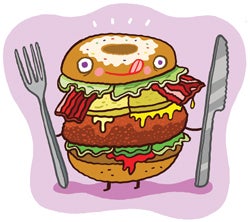 The award-winning team at URI Dining Services knows how to transform boring burger night into a special treat. Director Steven Mello ’86 brings the sauce with these designer options, featured at Astro’s Retro Burger Station at Mainfare Dining Hall.
The award-winning team at URI Dining Services knows how to transform boring burger night into a special treat. Director Steven Mello ’86 brings the sauce with these designer options, featured at Astro’s Retro Burger Station at Mainfare Dining Hall.
The Chunky Train Wreck Pepper jack cheeseburger, glazed in salsa, then topped with a spicy avocado spread, bacon and lettuce with a Sriracha drizzle.
The Asian Burger Burger glazed in a sweet and hot chili soy sauce, topped with lettuce and slaw made from cucumber, carrots, onions, and bean sprouts in a wasabi dressing.
The Italian Stallion Mozzarella cheeseburger with sundried tomato bruschetta, mesclun greens, a dollop of Italian spice-seasoned mayo and a drizzle of balsamic reduction.
Decadent Doughnut Burger A cheeseburger topped with spicy peanut butter, lettuce, bacon, and a fried onion ring, all inside a grilled glazed doughnut.
The Tipsy Texan A burger smeared with pimento cheese, peachy bourbon BBQ sauce, lettuce, tomato and onion.

Lawns cover 30 million acres in the U.S. and each year, we apply nearly 80 million pounds of pesticides in pursuit of suburbia’s mythical green carpet. In fact, homeowners use 10 times more chemical pesticides per acre on their lawns than farmers do on crops. That’s a lot of collateral damage to water quality and aquatic life, says Professor of Plant Sciences Bridget Ruemmele, not to mention exposure for homeowners and their pets—remember, it’s not called weed killer for nothing. The first step in going chemical free is to send your soil off to be tested.
• Most plants like soil to have a neutral pH of six or seven; if it’s lower, consider adding lime.
• Use fertilizers made of animal or plant composted materials with a ratio of 3-1-2 nitrogen/phosphorous/potassium. Apply two pounds per 1,000 square feet.
• Clover fixes nitrogen in the soil via the Rhizobia bacteria, which converts nitrogen gas into a useable form. Embrace it.
• Fall is the best time to plant your lawn because grass has two seasons to establish itself before the punishing heat and dryness of summer.
• Loosen compacted soil by adding compost as a top dressing and renting a plug aerator, which pulls half-inch plugs of soil from the lawn to let air and nutrients in. Dispatch built-up thatch (dead grass) with a good garden rake.
• Don’t mow lower than two inches—you want to keep light away from lurking weed seeds.

You want to be online. You need to be online. But you’re aware of the threats: It’s too easy for attackers to get usernames and passwords, whether through phishing scams, malware, wifi “sniffing” or hacking. URI’s Digital Forensics and Cyber Security Center, a U.S. Department of Homeland Security Center of Academic Excellence in Education and Research, says you can secure your cyber life using the simple technique of multi-factor authentication. With it, those stolen pieces of information are no longer the keys to the castle. Many online services, from financial institutions to Google, provide it for free. There are three primary factors:
- Something you know—e.g. your (strong) password
- Something you have—e.g. your phone
- Something you are—e.g. your finger print
For instance, log on to a Google service like Gmail from an unknown device, and Google texts a code to your phone that you must enter alongside your password to get into your account. An attacker may have your credentials, but likely won’t have your phone—your account is safe. (You can set trusted devices like your phone to require this less often if it’s annoying.) What if someone who knows your password also gets your phone? This is where the third factor comes in—something you are. If your phone is set to require your fingerprint, which most modern phones are capable of, the attacker still can’t get that authorization code.

The growing popularity of 3D printers may make traditional craftsmanship seem a thing of the past. But for those without access to one—and those who just prefer to make things by hand—PVC pipe is the perfect alternative.
PVC is a thermal-forming plastic, says Ying Sun, M.S. ’82, professor of electrical, computer and biomedical engineering, which simply means that if you heat it up, it will get soft, then harden again as it cools. Sun uses a hair dryer to make PVC pipes “as soft as Play-Doh,” then flattens the PVC into a sheet, cuts it into a shape, and forms it into a finished product. He teaches engineering students to make whatever parts they need this way: clips to attach batteries to circuit boards, safety equipment so children with disabilities can enjoy ride-on toys, and even an entire custom wheelchair for a paralyzed dog. In his new class, “Technologies and Music,” his students will make PVC flutes.
PVC is not just useful in the classroom. Sun made a long-handled shoehorn, for instance, so he can put his shoes on while standing up, as well as a paper-towel holder and clips to mount flashlights and other tools in his workroom. He has even seen PVC archery bows. Best of all, he points out, it’s cheap and available. The only limit is your imagination.

As bathroom design motifs go, the beach—rendered by jars of seashells, seahorse figurines and sandpiper prints—is a ubiquitous link to the natural world of rocky tide pools and bountiful estuaries. But there’s a hard-bitten irony there. We may celebrate our modern bathroom as fundamental to our advanced civilization, but actually, we are often thwarting mother nature’s gut—to the detriment of our waterways.
Let’s back up. Naturally occurring bacteria thrive on our daily waste. Engineers and scientists have designed two methods of aiding them in their work, slowly degrading—or actively processing—the waste before it begins the slog to our waterways. A septic system separates solids and liquids, then holds onto the sludge for regular pumping out and percolates the liquid through gravel and soil rife with yuck-loving bacteria. Treatment plants mirror that process by using tanks to separate liquids and solids. More tanks introduce oxygen and stimulate microbe growth, followed by heat treatment of sludge and filtering of effluence to kill off toxic bacteria.
These systems keep us healthy by guarding the health of our fragile ecosystems. Yet we disrupt them. It’s estimated that nationwide, about a third of prescribed medications are partially or never used—and often flushed down the toilet, out of fear that a child or pet might get at them. Once flushed, they pollute waterways and the flora and fauna that inhabit them, and eventually, our own food web. Fish have been found with traces of antidepressants; contraceptives add hormones to our water.
Consider, as well, theoretically flushable items ranging from baby wipes and paper towels to condoms. These items are either slow to degrade and so gum up the works (paper towels), or are not biodegradable at all (condoms) and are unsightly when storm events or needed repairs result in treatment plant overflows. They belong in the trash.
We all want and need clean water. Let your décor serve as an incentive to treat the care of our waterways with the same attention and consistency as the cleansing of our bodies.
By Judith Swift ’68, director of URI’s Coastal Institute and professor at the Harrington School of Communication and Media
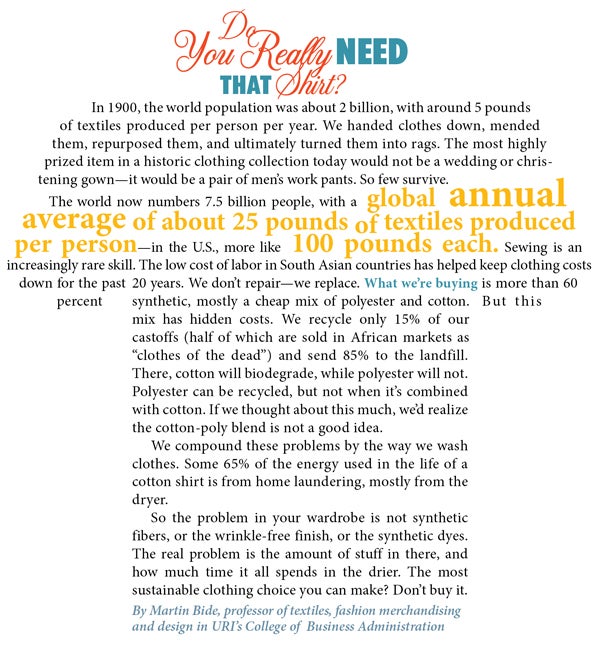

For every aspiring home gardener who has ever wandered a nursery in search of the right plants to compose a Better Homes and Gardens-worthy landscape, Kate Venturini ’06, M.S. ’10 , a graduate of URI’s Landscape Architecture and Marine Affairs programs and URI Cooperative Extension educator, has this advice:
Plant for nativity. The entire food web is built on insect health, so incorporate native plants that support diversity and beneficial insects.
Plant in swaths. Place like species together in groups of three or five. Plants have more visual punch in a mass; don’t dot the bed with singles.
Plant in layers. Let the forest—a fine model of an ecosystem in which you have canopy and understory plants—be your guide. The vertical layers capture storm water and decrease run-off.
Plant for all seasons. Mix deciduous plants with evergreens so you have something to look at in the winter, and small mammals and birds have year-round habitat. And consider bloom time; something should be in flower at any point in the season, offering nectar or pollen to beneficial insects.
Plant in wavy curves. Nature doesn’t array itself in straight lines, and neither should your garden. Give your beds curved, undulating lines, and your plants a staggered line.

Here’s the thing, says URI career advisor Princess Metuge: The U.S. attracts skilled migrants, while international companies are always hiring U.S. nationals, especially in fields like tech, education, and English as a second language. So it’s important that today’s job seekers view the job market on a global scale. Put emphasis on soft skills: the ability to interact professionally with individuals at every level and from every cultural background; an understanding of various cultural interactions; the ability to speak another language, preferably Spanish, French, or Chinese. Companies want these skills whether they stay local, relocate overseas, or have offices all over the world.•

Imagine enjoying 75 degree temperatures, earthy spring smells and home-grown tomatoes long after everything else has gone by and the temperatures hover at 40 degrees. You can get more growing days—if not weeks—by building a hoop house to get plants going and keep them going in the shoulder seasons of early spring and late fall. “You are essentially putting up a miniature greenhouse over a garden plot,” says Andy Radin, a Research Associate and Ag Extension Agent for the Plant Science and Entomology department. You can buy a kit, or you can head to your nearest home improvement store to get most of the materials.
Materials:
- 10 x 20-foot garden bed
- 10 4-foot pieces of rebar, concrete reinforcement bar
- 2 2-foot pieces of rebar
- 7 10-foot foot pieces of ½-inch schedule 40 PVC pipe, cut into 22-inch lengths (10 22-inch pieces)
- 2 50-foot lengths of very strong twine or thin rope
- 2 6-foot lengths of rope
- 20 8-inch zip ties
- 32 x 15-foot piece of greenhouse-grade plastic sheeting (available online)
- 10 Large binder clips (available from office stores)
To build:
Drive the 4-foot lengths of rebar 2 feet into the ground in two parallel lines about 8 feet apart. Within each row, the posts should be about 5 feet apart.
Slip a 22-inch sleeve of PVC pipe over each one of the rebar posts. Use the 10-foot lengths as tunnel hoops by slipping one end over the remaining 2 inches of rebar projecting above each sleeve and then bending it over to the corresponding rebar in the other line of posts. It will take some strong bending in order to prong it onto the post. The highest point of the hoop should be about 5 feet.
Take a zip-tie down to the base of the rebar posts and loop it around. Slip another zip-tie into the loop you just made, but don’t cinch it tight. You are creating one in a series of loops that serve as anchor points for the structure that will keep the plastic roof and walls in place. Make loops at the base of all ten posts.
Take two 2-foot rebar posts and pound them into the ground about 5 feet out from either end of your hoop house, and tipped back at an angle from the structure. Leave 6 inches showing, and put something luminous on the end, like paint, so you can see them.
Take a piece of cord or twine and tie it to one of those ends. Loop it around the first PVC pipe arch at the highest point in the center. Continue looping it around each of the five arches. Secure it to the second rebar stake at the opposite end, with no slack. You are creating a ridge pole to prevent sagging.
Drape your plastic sheeting over the arches and center rope beam.
To secure the plastic sheeting, take one of the 50-foot lengths of rope and knot it around the zip-tie at one end of your hoop house. Thread it over the hoop and around the zip-tie on the second post on the opposite side. Continue staggering the rope in a zig-zag pattern until you reach the other end of the hoop house. Take the second 50-foot length of rope and stagger in the opposite direction to create a crisscross over the center line. This is like lacing up a shoe.
Gather the excess plastic sheeting on the ends and bunch together, and bind with one of the 6-foot lengths of rope.
To let out excess heat, roll the plastic inward (to prevent rain from accumulating and weighing it down). Secure the roll-up on each side by clamping the roll tightly with binder clips, five on each side. Roll it down to keep the heat in. Keeping the roll-ups in place may take some trial and error, but persist!
Voila! Private greenhouse for $75 and an hour of your time.

Save the Planet—and Your Wallet
Residential energy efficiency in the U.S. has a huge opportunity for improvement. Though homes are more efficient today, they are larger with more stuff in them, increasing energy demand. The U.S. Energy Information Administration estimated in its Annual Energy Outlook 2017 that the residential sector used about 1,410 billion kilowatt hours (kWh) of electricity in 2016. In 2012, the annual average bill was $1,945 for heating, cooling, appliances, electronics, and lighting. Are you making the best use of your kilowatt hours? Gretchen Macht, assistant professor of sustainability and human systems engineering in the College of Engineering, says there are many low-cost ways to drive down your energy use. “They aren’t sexy,” she says. “But when your bill is much less, it’s really sexy.”
Download the Department of Energy’s Energy Saver Guide – 44 pages of no-cost, low-cost ideas to save money on energy use: lower the temperature of your water heater; plug televisions and other devices into power strips that you can turn on/off when not in use; take short showers over long baths; switch lights to LEDs; install low-flow faucets and shower heads. “Do the small things first,” Macht says “A lot of little things can go a long way.”
Invest in an energy audit. There are online tools for a DIY assessment or you can contact your local utility or an energy contractor to determine where you use and lose the most energy, and which improvements will deliver the biggest benefits. Ultimately, air sealing, more insulation, high efficiency water heaters and mechanical systems are retrofits that can increase any home’s energy efficiency. The U.S. Department of Energy estimates that energy efficiency upgrades can save homeowners 5–30 percent on their monthly energy bills.
Buy ENERGY STAR products. In 1992, the U.S. Environmental Protection Agency launched ENERGY STAR, a voluntary energy efficiency program. You can find the blue ENERGY STAR labels on everything from clothes dryers to computers to decorative light strings—products in more than 70 categories that meet the energy efficiency requirements in the ENERGY STAR product specifications. ENERGY STAR products are often eligible for federal tax credits, sales tax exemptions or rebates. The EPA estimates that the program saved businesses, organizations, and consumers $24 billion in 2012.
Buy part or all of your energy from renewable sources. Most utilities nationwide offer residential customers the option to buy some of their power from wind and solar sources. Sometimes it costs a little extra, but some companies even provide up to 50 percent renewable energy at no additional cost. Macht argues that it’s a small cost to pay for drastically reducing your carbon footprint.
Generate your own power. Many utility companies also have programs for homeowners who want to install residential solar panels. They can walk you through how to choose a system that is appropriate for your home and set up a net-metering billing arrangement. Net-metering allows you to sell back to the grid any solar-generated electricity you don’t use. Some states have net-metering laws, regulations or voluntary programs—their terms vary widely. Instead of paying an electric bill, how about the power company sending you a check at the end of the year?

Use Your Public Academic Library
If you live near a public college or university, their doors may be open to you. Even if you don’t have a student ID or credentials to use their research tools off-campus, you can try a search in Google Scholar (Google’s more sophisticated research tool) and consult with librarians at the library to see how you can access the articles that appear in your results.

Every package in the grocery store seems to shout out a health claim. The reality is that a healthy diet consists of whole foods, with minimal processing, says Dara LoBuono, M.S. ’14, a Ph.D. student in URI’s Department of Nutrition and Food Sciences. Here’s her guide to healthy label skepticism:
Natural There is no government regulation or definition for this term. A whole raw chicken can be labeled as natural, but contain preservatives such as added salt to maintain shelf life. Added sugar and high fructose corn syrup can appear as “natural sweetener.” Cheese labels can say “natural,” even though no cheese is naturally yellow.
Organic Research indicates organically grown foods have no nutritional advantage over conventional goods. They do have lower levels of pesticide residue, but there is no evidence that residue exposure poses a risk to health.
Fine Grain Look for terms like “whole grain” or “100 percent whole wheat.” Watch out for “7-grain,” “multigrain,” or “made with whole grain,” as these breads likely contain refined white flour, which is stripped of the healthiest portion of the grain. Coloring is no guide—bread can be made dark brown with caramel.
Good Gluten Gluten is a protein found in wheat, rye and barley that people with celiac disease and gluten intolerance must avoid. Gluten-free diets may also benefit those with other autoimmune diseases, but evidence is inconsistent. For the rest of us, there is no benefit in buying gluten-free. These products not only cost more, but may have less fiber and higher calories.
The Immunity Trap Labels that claim a food supports immunity or wards off disease are usually misleading. A product might contain nutrients associated with immune health, but that doesn’t make it a healthy choice. Juice may give you tons of vitamin C, but only at a high price in sugar.

The Arthritis Disease Center estimates that 50 to 80 percent of Americans will experience back pain due to poor posture. “I’m a physical therapist and even I once hurt my back,” says Anne-Marie Dupre, clinical assistant professor of physical therapy. “I was lifting—a paper clip! Sounds crazy? I was startled from behind while rounding my back, quickly got up and turned. Ouch.”
Don’t:
- Get “text neck” from looking down at your phone as you walk.
- Sit all day at a computer with head tilted forward, shoulders hunched and pelvis tilted back, which leads to tight chest and hip muscles and a weak back.
Do:
- Practice proper alignment, with core activation. That’s earlobe over shoulders, shoulders over hips, hips over knees and knees over ankle joints, with abdominal muscles drawn back toward the spine. Think of it as a soldier standing at attention or a dancer’s stance.
- Strive for proper alignment when you move. To pick something up off the floor, keep your back upright—not pitched forward —and your core active as you bend at hips and knees. It’s okay to twist if you keep your back straight and your core active as you shift your weight to the side you are twisting to. Practice as you empty the dishwasher and make your bed; you’ll strengthen and build muscle memory, limiting your chances of injury.
 Home
Home Browse
Browse Close
Close Events
Events Maps
Maps Email
Email Brightspace
Brightspace eCampus
eCampus


